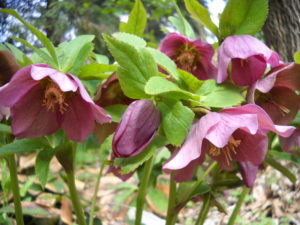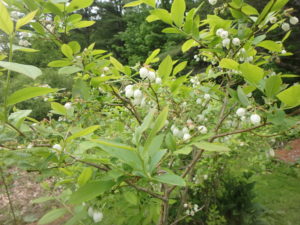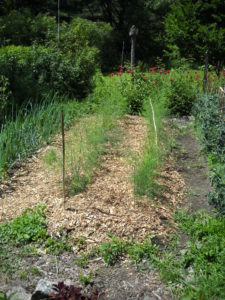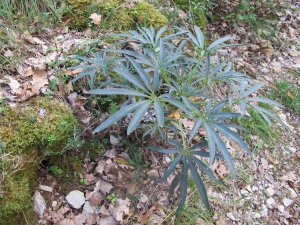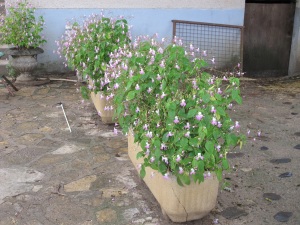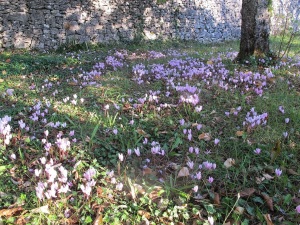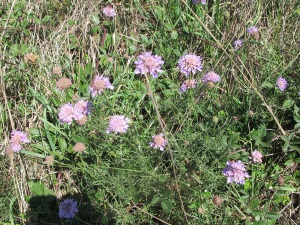Three Keys to a Successful Garden
Being a great gardener is pretty simple. Know what your plants need in terms of sun, soil and water. Do that, and make adjustments as necessary, and your plants will thrive. Of course, that is often easier said than done.
Sunshine is what drives plant growth. Vegetables and many flowers do best with full sun. Full sun is generally defined as 6 hours of direct sun. But not all sun is equal. The sun at noon is much stronger than sun at 6am. An hour of afternoon sun is, in my opinion, worth nearly 2 hours of morning sun.
But many trees, shrubs and perennials want part sun or light shade. That’s where the gardener must decide. Put those hellebores on the north side of the barn? Or perhaps under the dappled sun that filters through a maple? That’s why I like to buy perennials in multiples. Try some here, some there. To do so, starting some by seed makes sense as you have more plants to play with – without breaking the bank.
Starting perennials by seed is easier than you might think, but requires patience. Unlike annual flowers, most perennials will not flower the same year they are planted. Biennials like hollyhocks and many foxglove will bloom the year after you start the seeds, then die. But some hollyhocks defy the odds and come back to bloom, year after year – for good gardeners who cut them back right after they bloom.
The right soil is key for most plants. Some want sandy soil that drains quickly and stays relatively dry in winter because wet soils will rot their roots. Others need moist soils all summer or they go limp on hot days. You can learn by trial and error, but I try to minimize errors by reading up on a plant to see what soil it needs. My go-to book for this is Steven M. Still’s book, Manual of Herbaceous Ornamental Plants. It is over 800 pages of great information.
Soil pH, a measure of acidity, is important to plants. Most perennials do best in soils with a pH of 6.2 to 6.8 which is just shy of neutral (7.0). Know your pH by testing every 3 to 5 years, as pH is easy to adjust. Want blueberries? You must have very acidic soil, in the 4.5 to 5.5 range. You can spread elemental sulfur around the bushes, or add an acidic fertilizer made for holly and rhododendrons. Do that right after blooming.
I recommend getting a soil test done by a good lab every three years. Cooperative Extension in your state can do that for a fee. It will give you useful information about everything except nitrogen. Nitrogen levels vary considerably over the short term, so most labs do not measure them. But if you have good levels of organic matter, your probably do not have a major deficit. Organic fertilizers applied at planting time will boost nitrogen and add some for later in the form of slow-release nitrogen components in the mix. But don’t add too much fertilizer, especially chemical fertilizers that can burn roots and push fast, unhealthy growth.
Soil tilth and texture is important too. That’s what an experienced gardener learns by picking up a handful of soil and feeling it. Excellent soil is fluffy and does not compact easily. It has space for water and air. Moisten some soil and rub it between your fingers. If it feels sticky, it’s dominated by clay. If you feel many sharp bits, it’s sandy. A good loam is somewhere in between the two. You can improve clay or sandy soils but adding compost, lots of compost.
I make compost, but also buy it each year. I add some to every planting hole and every new bed. I mix it in with potting soil for container growing. I spread it over the lawn to improve it, and to nourish the roots of an aging maple with roots under the lawn. Earthworms will work the compost into the soil, so I don’t have to.
Moisture is key for all plants. For most, all growth stops when the soil dries out. And watering a plant that is flopping over and gasping for breath does not fix the problem immediately. Yes, most plants will look better within a day of watering, but it can be a few days or a week before they recover fully and start growing. In hot times, monitor moisture by eye or finger, especially for seedlings just planted.
Mulch is great for holding in moisture. It protects the soil from the sun’s desiccating heat. It minimizes evaporation. It helps to prevent weeds from growing.
An inch and a half or two inches of finely ground bark mulch will do a good job of preventing most annual weed seeds from growing – but will not deter roots of pernicious weeds from sending up sprouts. Heck, I’ve heard stories of Japanese knotweed growing right through asphalt driveways, and I know witch grass and ferns will pop up through most mulches.
One of the great things about getting older is that I’ve made plenty of mistakes – and learned from them. We all kill plants. But doing your homework and paying attention is really important. Learning from our errors and omissions makes us great gardeners.
Henry’s website is www.Gardening-Guy.com. You can reach him by e-mail at henry.homeyer@comcast.net or send a letter to P.O. 364, Cornish Flat, NH 03746. Please include a SASE if you want a mailed response.
On Traveling and Gardening
Being a gardener enhances my enjoyment of almost anything I do – including traveling. I recently went to France to hike a section of the Chemin de Saint Jacques de Compostelle. This is an ancient pilgrim’s trail through France and Spain (where it is called the Camino); it’s a thousand miles long and people have been walking it for over a thousand years.
Part of my joy in this trip was seeing what was growing as we walked along, particularly plants we grow as perennials here in New England but grow there as weeds or wildflowers. I also enjoyed seeing species of plants that are in the same genus (a scientific grouping of closely related plants) that are different species, but similar to ours. And seeing how things grow there informs me about what specific plants need.
Everywhere we walked we saw the light purple or heather-blue flowers of pincushion flower (Scabiosa spp.). It grew in fields, competing with grasses, and along roadsides. The soil in the part of France where we hiked was full of limestone rock, so it must be somewhat alkaline. I’ve grown this perennial, but it has never thrived for me, dying out after a year or two. I think if I plant it again, I will add some limestone to the soil. A cup of limestone worked into the soil around a trio of plants should help.
Jewelweed or touch-me-not (Impatiens capensis) is a tall weed that thrives in shade and produces seed pods that, when ripe, can propel seeds several feet when touched. Along my hike I saw a relative, probably Impatiens glandulifera, that not only appeared along the trail but also in gardens. This one is shorter than ours, two feet tall or less, and has nice pinkish flowers. Weed or garden plant? I saw it in planters, so I guess it is considered a garden plant there.
Speaking of weeds, I saw a little purple loosestrife in France, but never in the huge swaths have I seen it wetlands here. I saw a few plants alongside a disturbed area by a man-made lake. Everything I have read about this invasive here has told me that in Europe, where purple loosestrife came from, there are many natural insect predators to keep it under control; here are there are no natural predators. The plants I did see were much smaller than what I have seen here.
I saw large swaths of a bright yellow crocus, a large one that seemed to naturalize and spread nicely. I asked a local about it, he could only tell me that it was a type of crocus, but no species or cultivar name. I’ve grown fall crocus here, a beautiful purple-blue one that is the species that produces saffron (Crocus sativus). Unfortunately, it takes 7,000 blossoms to produce 3 ounces of saffron and mine, instead of naturalizing, have tended to disappear. Not sure if the squirrels are into saffron, or if the conditions where I planted them are not quite right.
Cyclamen is often sold as a very satisfactory houseplant here, but can also be grown as a fall-blooming outdoor plant. In France I saw huge patches of it blooming, mainly in shady places near homes, which made me think it was planted but I did see some growing in the wild, too. The variety I have grown is a species called Cyclamen neapolitanum. It has survived over the years, but rarely blooms for me, or if it does, it may escape my notice – it blooms just when my maples drop their leaves.
A plant that delighted and surprised me along the trail was stinking hellebore” (Helleborus foetidus). Hellebores are among my favorite flowers in early spring, though of a different species than the French one I saw – I grow lots of the kind called Lenten rose (Helleborus orientalis). The Lenten rose is hardy to zone 4 and has been hybridized in recent years to produce blossoms ranging from deep purple to peach and pink. It grows in shade or partial shade and has glossy evergreen leaves. The stinking hellebore has greenish flowers that are malodorous, hence the name. It is hardy here to zone 6, though I have grown it successfully – though I rarely get any flowers.
Hawthorns (Crataegus spp.) are very common France, both in hedgerows and in the wild. I have a green hawthorn (Crataegus viridis), a species commonly used as a street tree for its toughness, medium size, and red berries in winter. Mine is a variety called ‘Winter King’ which is commonly sold. There I saw numerous English Hawthorn (Crataegus laevigata). Interestingly, most had no berries, even though it was the right season for them. Birds don’t seem to like the berries of ‘Winter King”, but I suppose the English hawthorn berries might be appealing to French birds. Or was it revenge on the English for the 100 Years War?
There were so many other interesting plants growing in France I can’t describe them all. I saw purple kale grown decoratively, and sage grown in quantity for the color of its leaves. Fall anemones were common in gardens, and of course the French love their roses. And being on vacation, I always took time to smell the roses. So when you go on vacation, I hope you’ll take note of the plants and e-mail me if you see something wonderful.
Henry can be reached by e-mail at henry.homeyer@comcast.net or at P.O. Box 364, Cornish Flat, NH 03746. Please include a self-addressed stamped envelope if asking a question by regular mail.



